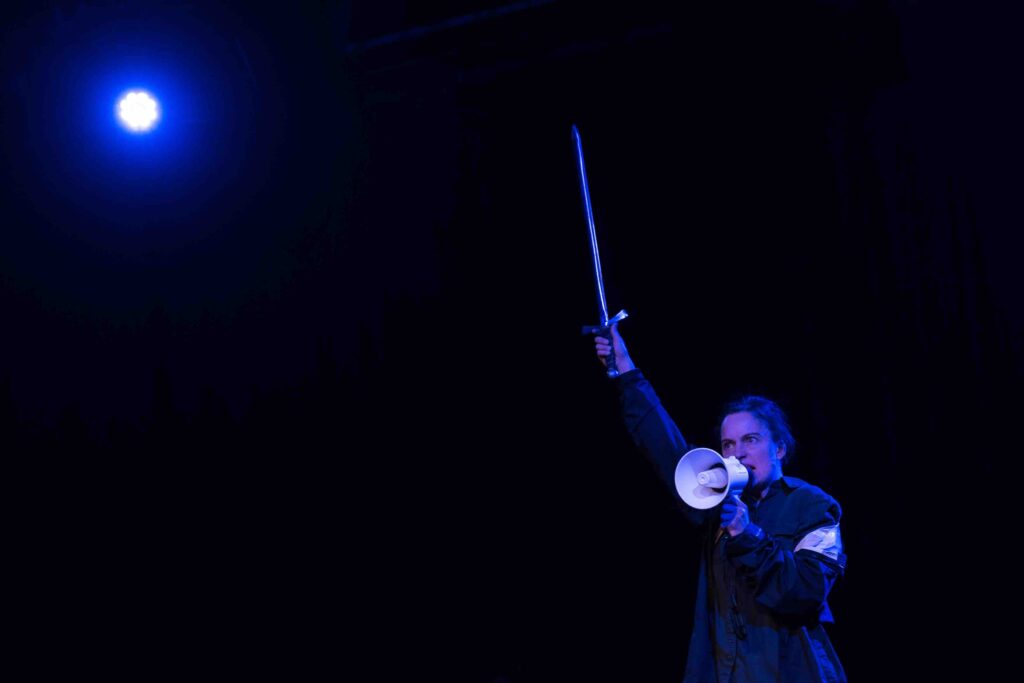
Joan of Arc existed in a time of great danger and superstition, in an era of war and witch hunts. Women’s place in the world was very traditional and limited. Janie Gibson’s one woman show Voices of Joan explores the trial of Joan in a minefield of misogynistic beliefs that have persisted to the present day.

St Joan was a 17-year old peasant girl from France who bravely led army forces against English invasion under the influence of divine inspiration. She was tried and burned alive at the stake by her enemies for crimes of heresy, sedition and witchcraft. Her extraordinary achievement and barbaric death might not mean much in today’s secular society that is a bit iffy about God, but beneath the surface of another history lesson, it’s undeniable that the patriarchy Joan was up against still exists. Whether it’s vitriol and abuse perpetrated by media, political figures etc, through to oppression and violence against women both home and abroad, the echoes of the past are still reverberating today, and cannot be ignored.
“Once a word is spoken, its sound exists forever.”
– Janie Gibson, Voices of Joan
Gibson’s punked up version of the passion of St Joan is an electric, ground-breaking production that feels inspired by Jesus Christ Superstar. Like the musical, Gibson extracts an iconic religious figure from history and grafts her onto a contemporary stage, excavating and examining all the evidence surrounding her trial in a profoundly confronting way.
Gibson embodies Joan as a modern teenager doing teenage things, laughing and giggling on the phone to her friends, and as a patriotic leader on a battlefield yielding a sword. Gibson also portrays her accusers with flamboyance and grungy intensity that is reminiscent of this rendition of Pontius Pilate in Superstar. But while mere parody would be entertaining enough, Gibson goes further and examines the spread of dangerous ideas through literature such as The Hammer of the Witches, a book so absurdly evil that it would be completely laughable, if it were not for the fact that it led to the execution of hundreds of thousands of innocent women.
Gibson doesn’t hold back in mocking the author’s obsession with blaming women for everything, including men’s fear of emasculation, holding up a giant wobbly penis on a platter searching for its rightful owner. Of course women are to blame! They make it go up – and down! If you don’t know where your masculinity went, try rummaging through a woman’s handbag – it’s bound to be in there somewhere!

These antics may be comical and a bit over the top, but this mindset isn’t far from the truth. For example, when a woman is intensely disliked, she is often accused of being a witch, and is subject to vitriol and abuse. Julia Gillard and Madonna are cited as examples. Meghan Markle also comes to mind. Gibson’s theatrics merely holds up a mirror to the fucked up reality we live in, where women with power or privilege that don’t submit to a socially acceptable standard are fodder for trash talk to sell magazines and score ratings.
In even worse cases in some parts of the world, a woman who is disobedient is left screaming in terror for her own life, but we rarely get to hear about them in the media.

In Joan’s case, she endured slander, public humiliation, imprisonment, assault and the most horrific violence imaginable. At barely 19 years old, she was burned alive at the stake, not once but three times to destroy all bodily remains, and her ashes unceremoniously dumped in the River Seine. 20 years later, the verdict was overturned and Joan was cleared of any wrongdoing. Her canonisation in 1920 solidified in her place in history as a martyr and a saint, one who would be remembered for her bravery and courage long after all her pious self-righteous accusers had perished.
Gibson commands the audience to participate in the trial and martyrdom of St Joan of Arc, not with force, but with gentle prompts and whispers, swapping clothing with audience members, asking them to read aloud or write things down, or getting everyone out of their seats and piling them all up for a bonfire scene. A candlelit vigil had me choking up with tears. Earlier, Gibson guided the audience to chant the word “cunt” over and over again, till it no longer sounded cheap and crude, but rightfully returned to its feminine origin.
Gibson and director Anu Almagro have proudly created a piece of theatre that’s unashamedly in your face and very weird; it makes you squirm when the spotlight is on you to be active, not passive, but the effect is true to the intention and character of St Joan; a rebel who wore men’s clothing, had tremendous courage, integrity and spirit and could command an army of people to do anything with her divine feminine power and authority.
Voices of Joan played at Brand X in Darlinghurst on 24 and 25 March. For more information about Whale Chorus Theatre Company, go to https://whalechorus.com/.
________
Image credit: Natasha Blankfield